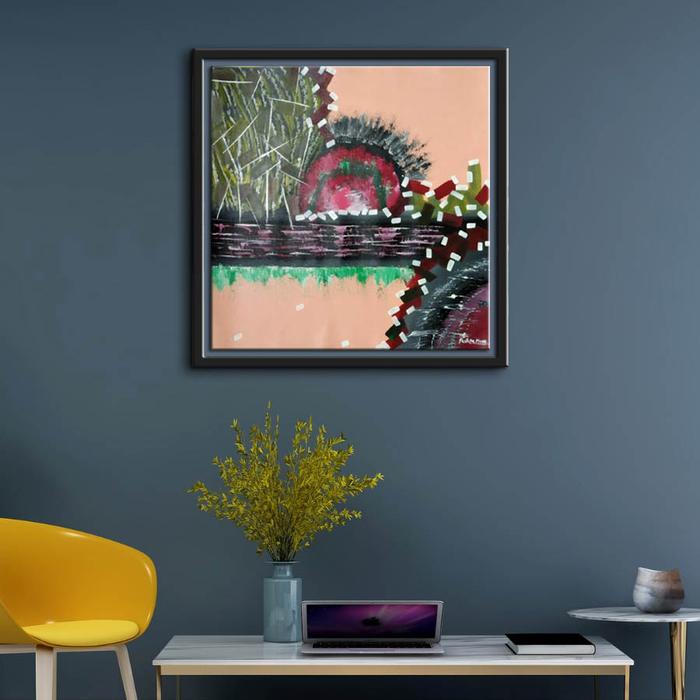Abstract art Paintings is a fascinating and dynamic genre that gives creators the chance to push the boundaries of their imagination and creativity. Abstract art is fundamentally about using non-representational shapes, colors, and textures to convey feelings, concepts, and ideas. But dissecting abstract art into its component parts is necessary in order to fully appreciate and comprehend it. Line, shape, and texture—the three essential components of abstract art—will all be discussed in this blog.
Introduction
Abstract art can be a little intimidating at first glance. With no recognizable objects or figures, it can be hard to understand what the artist is trying to convey. However, by breaking down abstract art into its essential elements, we can gain a deeper appreciation of its beauty, complexity, and emotional power.
What is Abstract Art Paintings?
In contrast to the recognizable subject matter, abstract art paintings emphasize form, color, and texture. Abstract art uses non-representational shapes, lines, and textures to convey feelings, sensations, and ideas rather than trying to depict reality. Geometric abstraction, lyrical abstraction, color field painting, and abstract expressionism are some of the subcategories of abstract art.
The Elements of Abstract Art Paintings
Abstract art is fundamentally about the interaction of the three fundamental components of line, shape, and texture.
Line
One of the most fundamental components of visual art is the line, which is essential to abstract art. In abstract art, a line can have many different forms and can be thought of as a mark made by a moving point.
The Role of Line in Abstract Art Paintings
Abstract art paintings use lines to convey motion, direction, and energy, as well as to create visual harmony, balance, and tension. These lines can suggest emotions, ideas, and concepts without relying on recognizable forms, because they are abstract and non-representational.
Types of Lines in Abstract Art
There are many different types of lines that can be used in abstract art. Some common examples include:
- Straight lines
- Curved lines
- Jagged lines
- Broken lines
- Thick lines
- Thin lines
- Gestural lines
Shape
Shape is another critical element of abstract art, referring to the two-dimensional area created by lines or colors. Abstract art uses shapes to enhance depth, balance, and composition.

The Importance of Shape in Abstract Art
Abstract art relies heavily on shapes because they give the composition a framework. Although they do not depict recognizable objects, shapes in abstract art can still be used to convey a sense of space, depth, and perspective.
Types of Shapes in Abstract Art
Geometric and organic shapes make up the two main categories in abstract art. Geometric shapes are those with distinct edges and symmetry.
On the other hand, organic shapes are erratic shapes that frequently resemble those found in nature.

Texture
The third fundamental component of abstract art is texture, which describes how a piece of art looks on the surface. Artists can use different materials, brushstrokes, and techniques to create texture in abstract art. Texture is employed in abstract art to evoke a sense of depth, contrast, and tactile interest.
The Significance of Texture in Abstract Art
Texture plays a crucial role in abstract art because it can arouse the viewer’s interest visually and tactilely. Additionally, texture can be used to add depth and contrast to a piece of art, enhancing its emotional impact.
Types of Texture in Abstract Art
Texture can take many different forms and be used in abstract art. Typical illustrations include:
- Smooth textures
- Rough textures
- Irregular textures
- Grained textures
- Glossy textures
- Matte textures
The Relationship Between Line, Shape, and Texture in Abstract Art
Abstract art is incredibly complex and fascinating because of the interaction between line, shape, and texture. Shapes can be made from lines, and textures can be made from shapes. Additionally, texture can be used to add interest, depth, and movement to a composition.

Examples of Famous Abstract Artworks That Use Line, Shape, and Texture
Numerous well-known abstract works of art make excellent use of line, shape, and texture. Among the most well-known are:
- Kazimir Malevich’s “Black Square”
- Piet Mondrian’s “Composition II in Red, Blue, and Yellow”
- Jackson Pollock’s “Number 1A”
- Mark Rothko’s “No. 61 (Rust and Blue)”
- Wassily Kandinsky’s “Composition VIII”
How to Interpret and Appreciate Abstract Art That Uses Line, Shape, and Texture
It can be difficult to interpret and appreciate abstract art that makes use of line, shape, and texture, but it can also be incredibly rewarding. It’s crucial to approach abstract art with an open mind and be prepared to interact both emotionally and intellectually with the piece in order to get the most out of it. One strategy is to concentrate on line, shape, and texture elements and how they interact to produce meaning and emotion.

Note:
Buy Paintings Online From Dirums
Dirums, a website dedicated to selling paintings and spreading knowledge about traditional Indian paintings, features an online art gallery showcasing works by renowned and emerging artists from across the Indian subcontinent.
FAQs
Figurative art represents recognizable objects or figures, whereas abstract art is not.
Abstract art contains more than just a collection of shapes. It is a conscious and intentional expression of sentiment, concepts, and ideas.
No, but knowing the background and significance of an abstract piece of art can help you appreciate it more.
No, anyone who has an open mind and is willing to interact both emotionally and intellectually with the artwork can appreciate abstract art.
Yes, the use of line, shape, and texture in abstract art can communicate ideas and messages, as well as the artist’s intentions and experiences.
Conclusion
In the rich and complex field of abstract art, there are countless avenues for inquiry and expression. We can better understand the beauty, power, and emotional impact of abstract art by dissecting it into its basic line, shape, and texture components.

